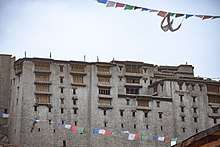Leh Palace



Leh Palace is a former royal palace overlooking the Ladakhi Himalayan town of Leh. Modelled on the Potala Palace in Lhasa, Tibet, the palace was built by King Sengge Namgyal in the 16th century. It is nine storeys high; the upper floors accommodated the royal family, while the lower floors held stables and store rooms.
Overview
Modelled on the Potala Palace in Lhasa, Leh Palace was built by King Sengge Namgyal in the 16th century. The palace is nine storeys high, where the upper floors used to accommodate the royal family, while the lower floors held stables and store rooms. The roof provides panoramic views of Leh and the surrounding areas, as the mountain of Stok Kangri in the Zangskar mountain range is visible across the Indus valley to the south, with the Ladakh mountain range rising behind the palace is visible in the north.
This nine-storeyed, dun-coloured palace is Leh's dominant structure. The palace was abandoned when Dogra forces took control of Ladakh in the mid 19th century and forced the royal family to move to Stok Palace. The now ruined palace is being restored by the Archaeological Survey of India. The Palace Museum holds a rich collection of jewellery, ornaments, ceremonial dresses and crowns. Chinese thangka or paintings, which are more than 450 years old, with intricate designs still retain the bright colours derived from crushed and powdered gems and stones. Sructures around the palace's base include the prominent Namgyal Stupa, the colourfully muralled Chandazik Gompa and the 1430 Chamba Lhakhang, with medieval mural fragments located between the inner and outer walls.
The palace is open to the public and the roof provides panoramic views of Leh and the surrounding areas. The mountain of Stok Kangri in the Zangskar mountain range is visible across the Indus valley to the south, with the Ladakh mountain range rising behind the palace to the north.[1][2]

Connectivity
The closest railway stations - Jammu, Pathankot and Chandigarh - are a three-day bus ride away.
The nearest airport is Leh Air Force Base Airport, 5 km from Leh Palace. Security checks are more stringent, as it is a military airport.
The Srinagar-Leh road follows the Indus river.
History
The construction of the palace on the Tsemo Hill was initiated by Tsewang Namgyal, the founder of the Namgyal dynasty of Ladakh in 1553 and was completed by his nephew Sengge Namgyal.
References
- ↑ Leh Ladakh
- ↑ Staff. "Monuments of India : Leh Palace". iloveIndia.com. Retrieved 2010-02-04.
External links
| Wikimedia Commons has media related to Leh Palace. |
Coordinates: 34°9′58.6″N 77°35′11″E / 34.166278°N 77.58639°E